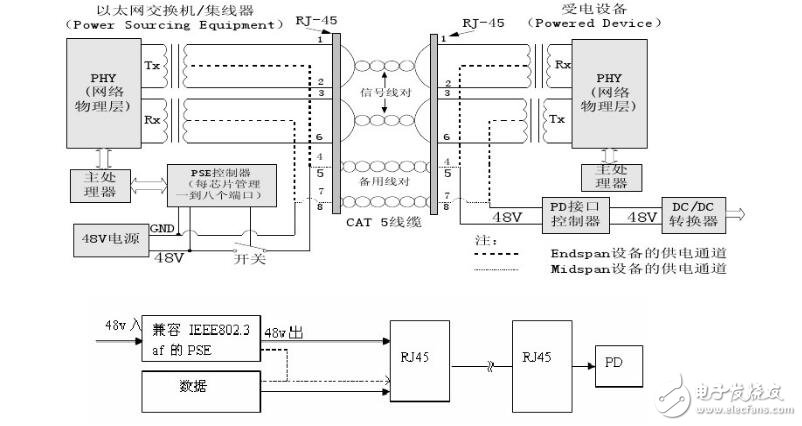Power over Ethernet (PoE) is a wired Ethernet local area network (LAN) technology that enables the current required to operate each device to be carried by a data cable rather than a power line.
In order for the Power over Ethernet to work, the current must enter the data cable at the power supply and output at the device terminal. This keeps the current from separating from the data signal and does not interfere with other devices. It is currently entering the cable through a component called an injector. If the device at the other end of the cable is compatible with PoE, the device will function properly and need not be modified. If the device is not compatible with PoE, you must install a component called picker or tap to remove current from the cable. This "picked-off" current is then routed to the power jack.
The composition of the Power over Ethernet systemIn a POE system, a device that supplies power is called a Power Sourcing Equipment (PSE), and a device that uses a power source is called a Powered Device (PD). The main purpose of Power over Ethernet is that it is responsible for detecting, classifying, powering on, and disconnecting the PD. It is a PSE, measurement, and other functions. Once a PD is loaded, the PSE will immediately detect the access of the PD and will shut down the power when the device is removed. The PSE must also provide overcurrent protection to protect the PSE and PD from damage. Two types of PSEs can be used, one is a termination PSE (Endpoint PSE), and the other is a mid-span PSE (Mid-span PSE).

The structure of the Power over Ethernet system
Power over Ethernet supports the needs of 5GBASE-T and beyondThe ever-changing market demand has led to the generation of robust standards in a timely manner. Based on this, the IEEE 802.3 standard and the evolving ability of Ethernet have been widely supported by the industry. In mid-2015, the IEEE P802.3bz 2.5/5GBASE-T working group unanimously defined physical layer specifications for 2.5GBASE-T and 5GBASE-T running on Category 5e, Category 6, or better via the IEEE 802.3 base standard.
Two important benefits of the 802.3bz standard include support for Ethernet power and Power over Ethernet (POE), which are expected to be formally approved in 2016 or 2017.
Panduit is a global provider of network infrastructure solutions and has been actively supporting IEEE 802.3bz as a 2.5G/5GBASE-T standard to ensure the performance and interoperability of switches, servers, PHYs, connectors and cables across the ecosystem. .
Earlier last year, the Ethernet Global Alliance formed its own Power over Ethernet Subcommittee to support the IEEE 802.3 project including PoE, 10, 40 and 100 Gb/s Ethernet, Next Generation Passive Optical Network (EPON) and more. For example, a 4-pair POE standardized in IEEE P802.3bt will provide at least 49 W to thin clients or other applications, such as intelligent building management systems.
Temperature testThe changing Ethernet landscape includes broader spectrum technologies and the challenges of increasingly demanding power supply capabilities.
Ethernet-enabled devices, such as digital signage, next-generation wireless access points, nurse call stations, and thin clients, have power requirements that go beyond existing PoE+ standards. This has prompted the industry to develop PoE++ devices to provide 51 to 71 W power. Such devices will be available early this year.
In the PoE + and PoE ++ standard installation wiring and connections, Panduit executives pointed out that the cable and connector itself can carry 960 mA of current and 71 W of power. The real problem is that cable bundling and temperature rise can cause cable insertion loss and application errors.
Extreme temperatures exceeding the recommended operating temperature range of the cable can damage the cable. Arcing can cause damage to the plug and socket when the PoE plug is removed.
For example, if 96 cables are required between floors, it is likely that a large bundle of 96 Category 6A cables will be required to support PoE++, or four adjacent 24 Category 6A 28 AWGs will run POE and limit the temperature rise to 15 degrees. .
At the same time, the International Electrotechnical Commission (IEC) has developed the test methods of IEC 60512-9-3 and IEC 60512-99-001 to solve the problem of arcing.
For better cable management, Vodafone offers a small wire diameter solution such as a 26AWG or 28AWG wire gauge to improve air flow and increase existing bridge capacity.
recommendFor future data and power needs, Panduit recommends having different power outputs to ensure redundant power supplies and stations. This requires two Type 6A cables to be routed to each powered device and each Category 6A cable from a different distribution area.
For example, by running two Category 6A cables, each capable of supporting 10GBASE-T and 71 W, you can be confident that it will support the cabling infrastructure for power supply for the foreseeable future.
Panduit recommends that all new installations use Category 6A because it supports the highest data rates for 10GBASE-T and bundles size limits in current or future PoE applications.
Case StudiesOne of Panduit's award-winning projects is Cisco Canada Headquarters, a LEED-certified building intelligence. It is a large commercial high-rise building that runs a single, converged IP network, powered primarily by POE. A structured Category 6 cabling infrastructure provides communication and primary power.
These features provide high efficiency and low operating costs as well as a comfortable and practical work environment. Panduit cabling provides POE connectivity to air conditioning controllers, closed-circuit cameras, door locks and LED lighting. The building features 1,400 PoE LED lighting fixtures and 1,800 PoE air conditioning system controllers.
The new Cisco Canada headquarters has been hailed as a striking example of how to use all the power of the Internet to create a truly sustainable and energy-efficient smart building.
Fiber Optic Equipment,Cctv Ip Camera Splitter,12V Waterproof Poe Splitter,Ftth Fiber Optic Patch Cord
Shenzhen Scodeno Technology Co.,Ltd , https://www.scodenonet.com